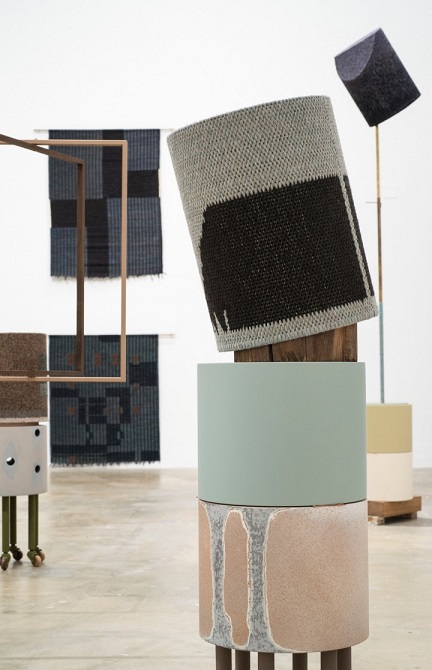Ultimately, Suki Seokyeong Kang’s use of the modernist grid is distinctly Korean.
installation view: Suki Seokyeong Kang: Black Mat Oriole (all images courtesy of the artist and the Institute of Contemporary Art at the University of Pennsylvania, and all photos by Constance Mensh unless otherwise noted)
PHILADELPHIA — Suki Seokyeong Kang: Black Mat Oriole at the Institute of Contemporary Art in Philadelphia is full of kinetic potential: thin rectangles are hinged together, shapes are folded, cradled, stacked. Her sculptures are connected through formal logic. They also share a soft palette that aerates weighty steel and wood, pulling these objects from the realm of the literal into that of the conceptual. They feel like traces of ideas, idealized forms. Seoul-based artist Suki Seokyeong Kang’s objects seem poised on the verge of becoming activated, in a tenuous space between what is aesthetic and utilitarian. Six-legged stools and small reed mats (called hwamunseok, hand-woven by Korean artisans) provide the first clue to this installation’s function: subtly scaling these formal geometries to the body. My strong desire to set them in motion was vicariously fulfilled by two dancers who staged an activation in the gallery while I was there.
A triptych video projection, also titled “Black Mat Oriole” (2017), deciphers these mysterious props, and is the core of the show. The video grows out of Kang’s interest in the Chunaengmu (Nightingale Dance) — a form of highly structured solo Korean Court dance once staged for royalty. It occurs entirely upon a hwamunseok. This rectangle becomes a geography of social mores, things allowed and things constrained, movements that have been defined by an architecture of tradition. She also investigates the Jeongganbo, the first East Asian musical notation system to simultaneously describe pitch and duration. Jeongganbo is a grid where each individual cell is called a Jeong, representing a single beat.
Suki Seokyeong Kang, still from “Black Mat Oriole” (2016-2017), 8 min 46 sec, 3 channel video with sound (courtesy of the artist and the Institute of Contemporary Art at the University of Pennsylvania)
Color is used with precision throughout Kang’s practice — and in the video installation. In the video, eight dancers clad in simple, black costumes activate the same objects seen in Kang’s sculptural installation, constructing their own stage. They move these rectangles, cylinders, stools, and frames through various configurations. For example, the rectangles transition from shallow plinths to tall stacks or upright steles. Together, these objects become the building blocks of Kang’s imagined geography. The dancers act as architects, but in turn, the sculptural shapes confine their movements; these bodies are tethered to that landscape, and they must contend with the grid as a metaphor for social structures. One dancer scoots across the stage on a wheeled rectangular platform, pulling herself forward with the heels of her feet. Another hops between the circular cutouts of a platform on the floor, and a third steps tentatively on a wobbly stack of platforms. Though the video is playful, there are moments when I wonder if that stack of rectangles will topple under a performer’s weight. There’s a precariousness here, something unwieldy that is masked by the way the individual scenes fold together into a symphony of form and color.

Installation view: Suki Seokyeong Kang: Black Mat Oriole
Upon first glance, Kang’s video and sculptures feel familiar. To view this work generously, (as I always try to do) I have to accept my lack of context, and reject the impulse to prescribe meaning. There is an undeniable resemblance between her spare, geometrically precise sculpture and the Donald Judds of art history — but her work is not indebted to the West. Black Mat Oriole is the first museum presentation of Kang’s work in the United States — and it is the latest exhibition to emphasize international canons of modern aesthetics. Exhibitions like this perform a public service: in case we have forgotten, they remind us of an obvious fact that grids, shapes, abstract forms, color, and lines are not elements invented by Western art, but are used by a range of cultures.
installation view: Suki Seokyeong Kang: Black Mat Oriole
Kang doesn’t buttress her work with modernist myths. She doesn’t bother making it more palatable to a Western audience by surrounding the exhibition with the language of minimalism. When I first saw the exhibition, Kang’s work immediately felt like an expansion of Clement Greenberg’s conception of painting — flatness, rectangular supports, and an emphasis on pigment are all qualities of her objects. Yet, my assumption of this relationship between Kang’s work and Western modern art theories reveals my own biases, molded by the Eurocentric ideas and histories espoused in our schools, museums, and culture at large. Ultimately, her use of the grid is distinctly Korean — the rectangle of the mat upon which this dance is performed, the history of Korean choreographed movement, and the written form of music are all particular to the history of that nation.
Through abstraction, Kang reminds us of the myriad ways we are funneled and constrained by ideological and physical borders. She touches these political subjects lightly, insisting on slow reading. In her insistence on following a Korean artistic genealogy, she accomplishes her ideological goals by simply doing. She doesn’t decolonize the Western canon, but instead holds up her own history. Perhaps this strategy is even more powerful.
Suki Seokyeong Kang: Black Mat Oriole continues at the Institute of Contemporary Art in Philadelphia (118 S. 36th Street) through August 12.



